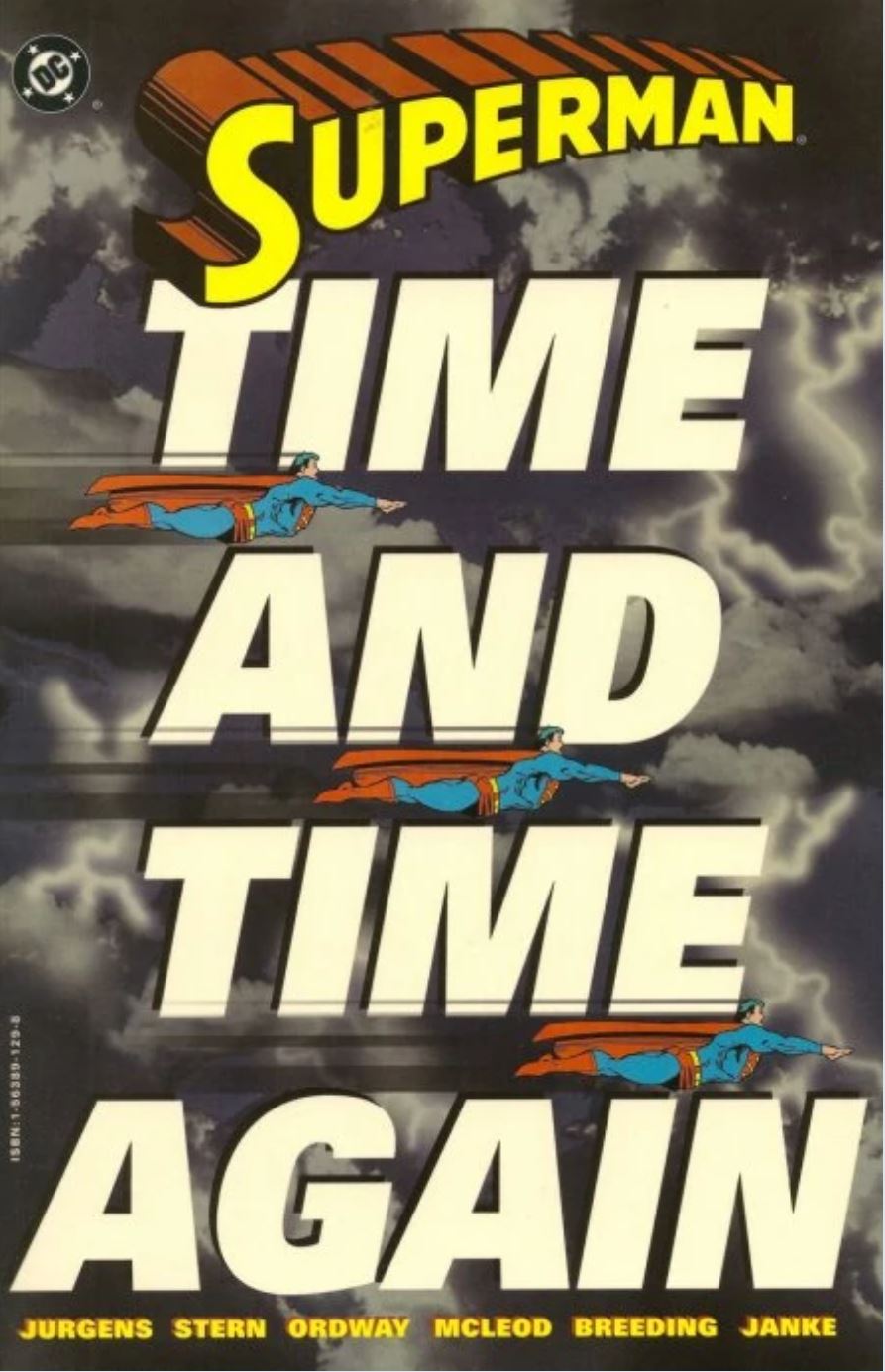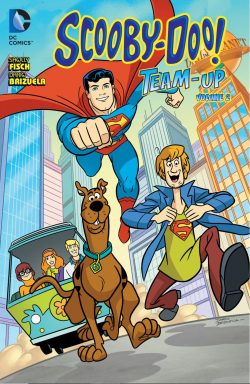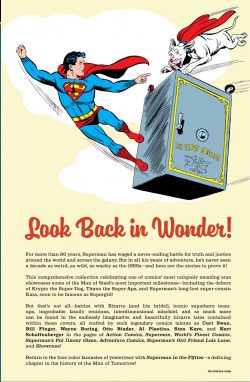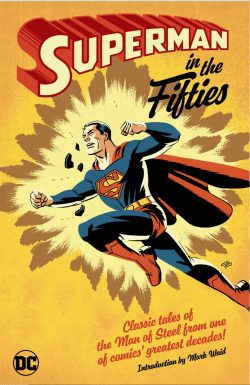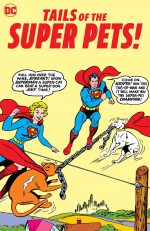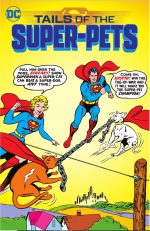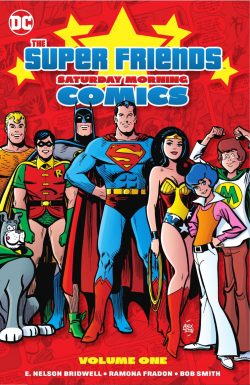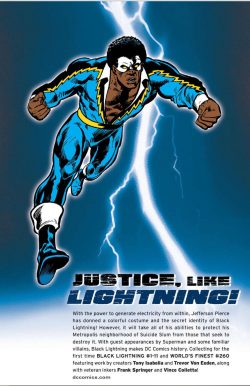

By Tony Isabella, Denny O’Neil, Trevor Von Eeden, Mike Netzer, Frank Springer, Vince Colletta & various (DC Comics)
ISBN: 978-1-4012-6071-2 (TPB/Digital edition)
Black Lightning was far from the first superhero of colour, but his mutability, iconic image and sheer tenacity have made him one of the most enduring and widely travelled. He’s been everything from outraged lone street vigilante to teacher; Presidential Secretary to perfect team player (on a succession of super-groups); sporting legend, family man and world-saving wise mentor. He’s even made the turbulent transition to star of his own television series…
Very little of that was apparent when these groundbreaking adventures were first released. Back then, the simple fact that an African-American masked hero was considered sales-worthy was the biggest leap imaginable…
Excluding a few returning characters in jungle-themed comic of the 1940s and 1950s, War comics first opened the door to black characters in the early 1960s, when Robert Kanigher & Joe Kubert created negro boxer Jackie Johnson as a stalwart of Sgt. Rock’s Easy Company in Our Army at War #113 (cover-dated December 1961).
Marvel followed suit with a black soldier in Sgt. Fury’s Howling Commandos (Gabe Jones, debuting in #1, May 1963), and pulled far ahead in the diversity stakes after introducing America’s first negro superheroes. The Black Panther premiered in Fantastic Four #52, (July 1966) and The Falcon first flew in Captain America #117 (September 1969). Luke Cage became the Hero for Hire in the spring of 1972, carrying a June cover-date…
The honour of being the nation’s first black hero to carry in his own title had already come and gone via a little-remembered (or regarded) title from Dell Comics. Created by artist Tony Tallarico & scripter D.J. Arneson, gunslinger Lobo was a vigilante of the wild west who sought out injustice just like any cowboy hero would. He first appeared in December 1965, with his second and final issue cover-dated October 1966…
Gradually, more ethnic lead characters appeared, with DC finally getting a black-skinned hero in John Stewart (Green Lantern #87, December 1971/January 1972), although his designation as a “replacement” GL might be construed as more conciliatory and insulting than revolutionary. By then, Jack Kirby had introduced teen New God Vykin the Black in Forever People #1 (March 1971) and later created enterprising “ghetto kid” Shilo Norman as a hero’s apprentice and eventual successor in Mister Miracle ##15 (August, 1973). DC’s first superhero to have his own solo title didn’t debut until 1977…
This astoundingly accessible, no-nonsense collection – comprising Black Lightning #1-11, material from Cancelled Comics Cavalcade #1 and World’s Finest Comics #260, spans April 1977 to January 1980) and bolts into action following a forthright and informative Introduction by originator Tony Isabella.
It begins as ‘Black Lightning’ (illustrated by neophyte penciller Trevor Von Eeden & veteran inker Frank Springer) sees former Olympic decathlete Jefferson Pierce return to the streets of Suicide Slum, Metropolis to teach at beleaguered inner city Garfield High School. Pierce is determined to make a difference to the troubled kids he used to be numbered amongst, but when the educator interrupts a drug buy on school grounds and sends the dealer packing, the door is opened to vengeance and tragedy…
When the mob – a crime syndicate dubbed The 100 – seek retaliation, one of Pierce’s students pays the ultimate price and the teacher realises he needs the shield of anonymity if he is to win justice and safety for his beleaguered home and charges…
Happily, tailor Peter Gambi – who sheltered Jefferson and his grieving mother after the elder Pierce was murdered – has some useful ideas and inexplicable access to pretty far-out technology…
Equipped with a strength-&-speed enhancing forcefield belt, gaudy costume, a and mask/wig unit completely changing his appearance, a fierce vigilante stalks the streets of Metropolis…
The local chapter of The 100 is run by monstrous, cunning freak Tobias Whale and once the assaults on his soldiers starts biting into profits and offer the downtrodden populace a glimmer of hope, he starts ruthless retaliation.
The sinister strategist lays many traps, culminating in hiring a lethal super-assassin who previously faced Green Arrow and the Justice League of America.
When the killer pounces, Pierce is forced into uneasy alliance with mystery woman Talia Al Ghul, but it ends as soon as bodies start piling up all over the school gym in ‘Merlyn Means Murder’…
Vince Colletta assumes the inker’s role as Black Lightning’s continued war against The 100 forces “the Whale” to fight smart, and Metro Police – led by doughty Inspector William Henderson – pursue the vigilante as vigorously as any gangster or felon. Taking seedy stoolie Two Bits Tanner into his confidence, Pierce savagely works his way up the criminal chain of command.
He eventually confronts Tobias in his inner sanctum only to find ‘Every Hand Against Him.’ As the police pounce, paranoia grips Pierce and he begins mistrusting his small team. Has someone he trusts betrayed him?
A more palatable answer seems apparent in #4 as suspicion falls on Tanner’s source – Daily Planet journalist Jimmy Olsen. When the outraged street fighter tries to force a confession from the baffled cub reporter, they are attacked by the 100’s latest super heavy in ‘Beware the Cyclotronic Man’…
Jimmy is wounded when they unite to fight off the atomic villain, and Black Lightning is suddenly confronted by the kid’s enraged and late-arriving best pal, who immediately jumps to the wrong conclusion and quickly shows why ‘Nobody Beats a Superman!’
In fact, had Cyclotron not switched attention to the true target Tobias wanted him to kill, everyone might have died, but the heroes’ misunderstandings are all forgotten when Black Lightning saves the Man of Tomorrow from nuclear meltdown, beats the bad guys and uncovers a mole in the police force…
Patience exhausted and under pressure from his own bosses, the Whale declares open season, placing an astounding bounty on Black Lightning. When deeply conflicted manhunter Syonide (and his hilarious, Marvel-baiting in-joke kung fu assistants) stalk the Saviour of Suicide Slum, their first move is to shadow and learn everything about their quarry.
When Gambi is abducted, Jefferson’s secret is finally exposed in ‘One Man’s Poison’, Syonide – afflicted with a bizarre sense of honour – hands over a helpless Black Lightning to the Whale in #7. However he cannot escape ‘The Conscience of the Killer’ and is compelled to shelter the captive tailor from the 100’s vengeance before voluntarily paying the ultimate price when ordered to kill the apparently-helpless masked hero…
Tragically, even as Black Lightning undergoes a miraculous transformation and takes out the gathered crooks and villains, he loses another innocent to the violent life he has embraced…
With the power of the 100 seemingly broken and Tobias Whale in custody, Pierce’s war should be over, but the gigantic gangster quickly breaks free and takes hostages from Police HQ.
Determined to end the vendetta, Black Lightning tracks him down for one last duel and in the ‘Deadly Aftermath’ finds the renewed purpose to carry on his alternate lifestyle…
Now considering himself more hero than avenger, Pierce experiences ‘Fear and Loathing at Garfield High’ when his school is invaded by a maniac terrorist operating an army of robotic killers, after which a circus trip exposes ‘The Other Black Lightning’. Sadly, although this well-meaning admirer is a mostly-harmless copycat, jewel thieves and former Flash foe The Trickster provide plenty of genuine danger and menace before the big top sawdust settles…
Comics were experiencing another general sales downturn at this time, and just as Denny O’Neil took over scripting Black Lightning, it was cancelled with #11 (October 1978).
‘All They Will Call You Will Be… Deportee!’ offered hints of a new direction with the urban avenger exposing a people-trafficking ring luring South American refugees into slave jobs at a fast food chain, but for most readers that was the last sight of the hero for some time.
So abrupt was the cancellation, that for legal reasons and to secure copyrights, DC had to put out black-&-white ashcan anthology Cancelled Comics Cavalcade, printing completed but unpublished stories of Claw the Unconquered, The Deserter, The Green Team, Madame Xanadu, Firestorm and others. Also included was Black Lightning #12…
The wider world got to see that last adventure – ‘Lure of the Magnetic Menace’ by O’Neil, Mike Nasser (nee Netzer) & Colletta – a year later when the January 1980 cover-dated World’s Finest Comics #260 ran the story as a prelude to a new series of BL adventures.
This edgy yarn details how the shocking hero is attacked by costumed crazy Doctor Polaris after Jefferson Pierce investigates a possible case of child neglect and abuse involving one of his more troubled students…
Wrapping up this initial outing is a copious selection of working drawings from the ‘Black Lightning Sketchbook’ by Von Eeden, and Mike Netzer’s unfinished cover for never-seen issue #13.
Although closely interlinked to then-current DC continuity, these fast-paced Fights ‘n’ Tights thrillers are so skilfully constructed that even the freshest neophyte can settle in for the ride without any confusion and enjoy a self-contained rollicking rollercoaster of terrifically traditional superhero shenanigans.
So, go do that then…
© 1977, 1978, 1979, 2016 DC Comics. All Rights Reserved.

